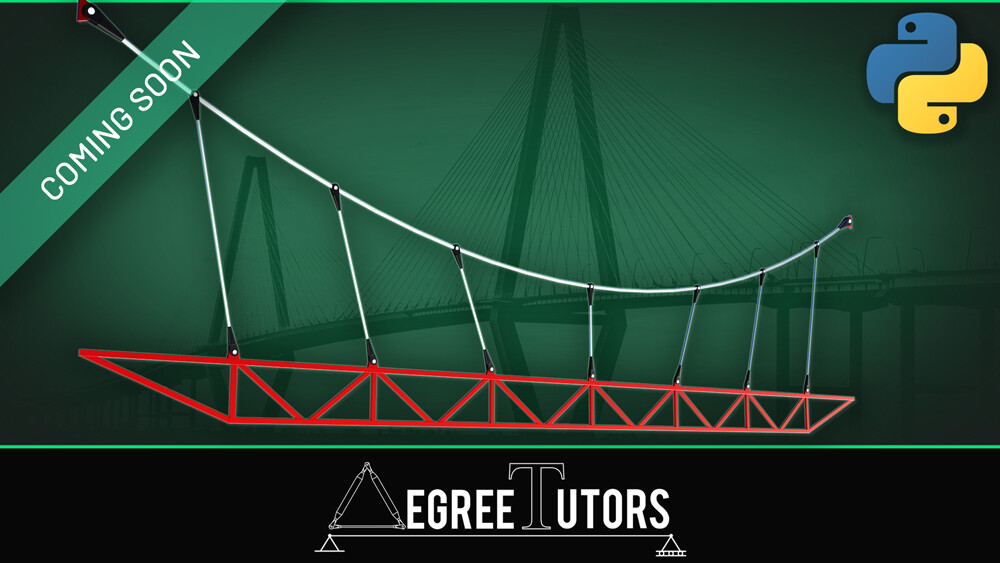Hi All,
I have a few more details to share about the upcoming course, Non-linear Finite Element Analysis of 2D Catenary & Cable Structures using Python. You’ll now see that the course is visible as ‘Coming Soon’ on DegreeTutors.com. I have quite a bit of recording and editing still to do so it will be another 4-6 weeks before the course is ready to take.
Here’s the course image - the structure on the front is one of the structures we will analyse in the course.
Here’s a breakdown and overview of the sections:
Introduction and Course Overview
In this introductory section, we’ll set the stage for what’s to come by taking a tour of the course and getting some preliminary housekeeping and setup out of the way.
‘Heavy’ Cables - the Linear Solution
Cables very often undergo changes in their geometry under loading, either due to cable extension or flex in the cable supports - they are the classic example of a non-linear structure. In this section, we’re going to establish a linear (closed-form) cable solution that ignores non-linear effects. This will provide a baseline case to test our non-linear code against later.
Getting Comfortable with Non-linearity
In this section, we’ll consider sources of non-linearity in structural behaviour before focusing on geometric non-linearity in particular. The aim of this section is to take any mystery out of the term ‘geometric non-linearity’. We’ll also explore, at concept level, how we might set about solving for the behaviour of a non-linear structure.
The Non-linear Stiffness Matrix
Non-linear structures exhibit a change in their stiffness as their geometry changes - this change in stiffness is literally what leads to the non-linear behaviour since linear structures have a constant stiffness that links applied loads and deflections. In this section, we’ll develop a non-linear stiffness matrix that can account for changes in stiffness due to large deformations.
Building our 2D Solver Toolbox
Now that we have a stiffness matrix that can reflect progressive stiffening or softening due to large deformations and we understand, conceptually at least, how to iterate towards a solution, it’s time to build out the code that can bring these ideas to life. In this section, we’ll do the bulk of our code development.
Visualising the Results
After the heavy-lifting of the previous section, we’ll tackle something a little less intensive in this section. We’ll build out the data visualisation that brings our solution to life. What we cover in this section will have a lot in common with previous DegreeTutors courses. This time, in addition to some aesthetic improvements, we’ll implement a feature that allows us to ‘step- through’ the converged stages of our solution.
‘Heavy’ Cables - the Non-linear Solution
By now we’ve nearly come full circle - we have code that performs an iterative analysis that tries to converge on the final state of the structure. In this section, we’ll compare our code’s results with the linear cable solution we developed at the start of the course. We’ll be able to closely approximate the linear solution but also observe the emergence of non-linear behaviour as the axial stiffness of our cable is progressively reduced.
Modelling Initial Geometry in Blender
In this section, we’ll use Blender to model and export the initial geometry of our structure. This will be a huge time-saver when dealing with larger structures. Again this will be similar to previous DegreeTutors courses however this time we’ll also introduce Blender’s cloth simulation tools which offer a quick and easy way of generating catenary geometry.
Mixing Cables and Bars in the Same Model
In this section, we’ll work on the versatility of our toolbox by implementing the ability to combine cable elements that can only resist tension and bar elements that can resist tension and compression in a single structural model. This marks the completion of our toolbox and leaves you in a good position to expand it further.
I’ll keep you posted as the course moves closer to completion.
Cheers,
Seán
